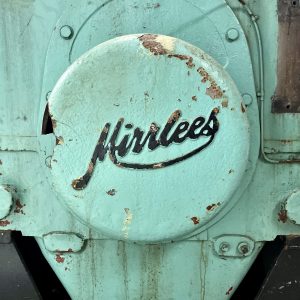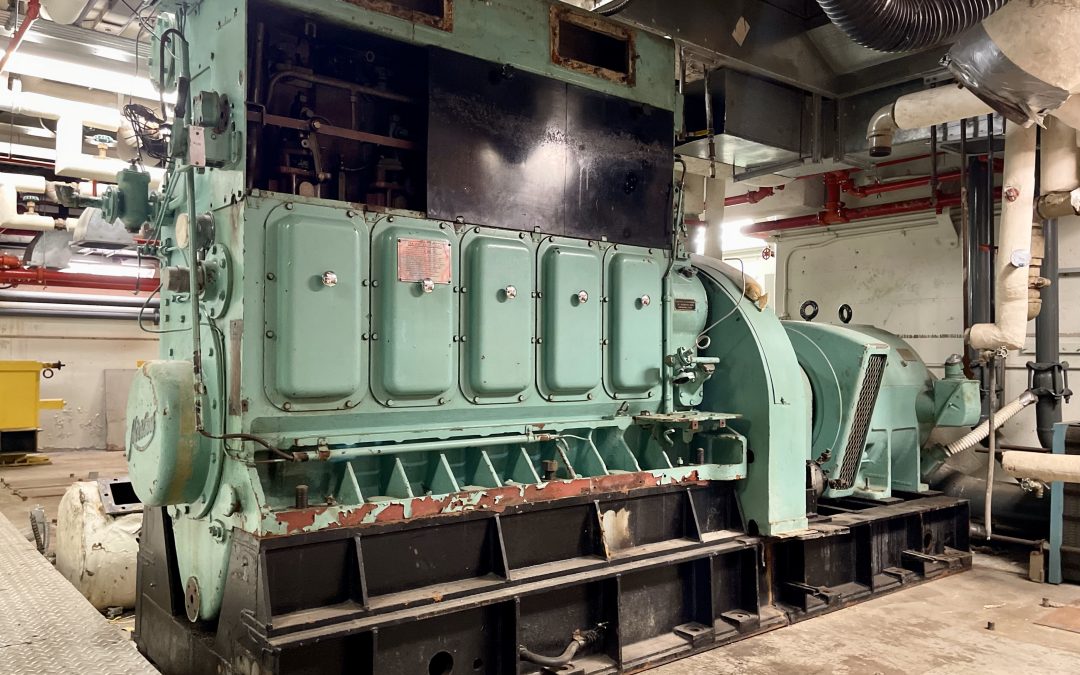(20/25)
As we continue to highlight 25 artifacts from within our collections for the Diefenbunker’s 25th anniversary, this week, in recognition of our newly unveiled Machine Room viewing platform, we are featuring a Mirrlees 5-Cylinder Diesel Engine.
The Machine Room is the heart of the Diefenbunker. This historic space was designed to sustain the bunker’s operations and had to be ready at all times to support 500 to 600 designated government officials, military personnel, and civilians who would have been stationed in the bunker for 30-day lockdown if a nuclear attack on Canada was detected during the Cold War. During the Diefenbunker’s construction between 1959 and 1961, and its operation as Canadian Forces Station (CFS) Carp between 1961 and 1994, there were dedicated individuals who worked extensively on the foundation, construction, and maintenance of the bunker. These workers also ensured that the machinery and self-sufficient systems within the Machine Room were running properly.
 This diesel engine from the Diefenbunker’s collections is mint green with silver and black components throughout. It was designed and produced by the British engineering company Mirrlees, Bickerton & Day Ltd. This company was founded in 1907 by Charles Day and Henry Neild Bickerton, with financial assistance from of the National Gas Engine Co. After undergoing various name changes, it was eventually named after partner J.B. Mirrlees. This company was known for the development of diesel engines that powered the first tanks used in World War I.
This diesel engine from the Diefenbunker’s collections is mint green with silver and black components throughout. It was designed and produced by the British engineering company Mirrlees, Bickerton & Day Ltd. This company was founded in 1907 by Charles Day and Henry Neild Bickerton, with financial assistance from of the National Gas Engine Co. After undergoing various name changes, it was eventually named after partner J.B. Mirrlees. This company was known for the development of diesel engines that powered the first tanks used in World War I.
This Mirrlees 5-Cylinder Diesel Engine currently in the Machine Room was acquired by the Diefenbunker in 2005 from the Regional Emergency Government Headquarters at Camp Borden. Today, it sits in the location of one of four original engines. To prepare for the arrival of this 6-ton unit, a custom cradle for the engine block had to be built in order to dismantle, transport, and reassemble the engine — unfortunately, it was installed backwards, which continues to be a running joke among former staff.
During the site’s operation as CFS Carp, there would have been four of these diesel engines in the Machine Room ready to provide backup power for the building if the lights went out. These engines were each maintained with over 6,000 gallons (27,000 litres) of diesel fuel. Two engines were required to power the building for 30 days, while the other two served as backup power.
Individuals like Wayne Byrne, Terry Currie, and Pierre Remillard served important roles in operating and maintaining the Machine Room. Wayne Byrne described how “you don’t realize how dark dark is ‘til you’re in here and the power goes out. Like, it’s so black, you just, you see nothing. Like, nothing.” Listen as he recounts the exciting and nerve-wracking realities of working with this type of equipment from his experience at the Diefenbunker between 1958 and 1961, and again from 1967 to 1983:
The Machine Room played, and continues to play, a crucial role in the building’s operations. Thanks to the support from the Ontario Trillium Foundation through the Resilient Communities Fund and the David & Susan Rose Fund – Ottawa Community Foundation, we have been able to safely open this historic space to the public for the first time. Immerse yourself in an engineering marvel on our newly installed viewing platform on your next visit underground.
Stay tuned as we continue to celebrate our 25th anniversary by uncovering stories from our museum’s collections.

